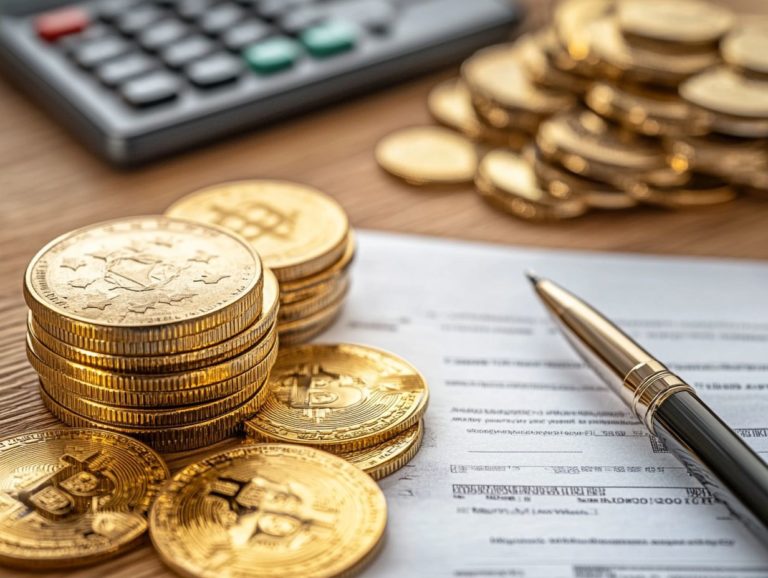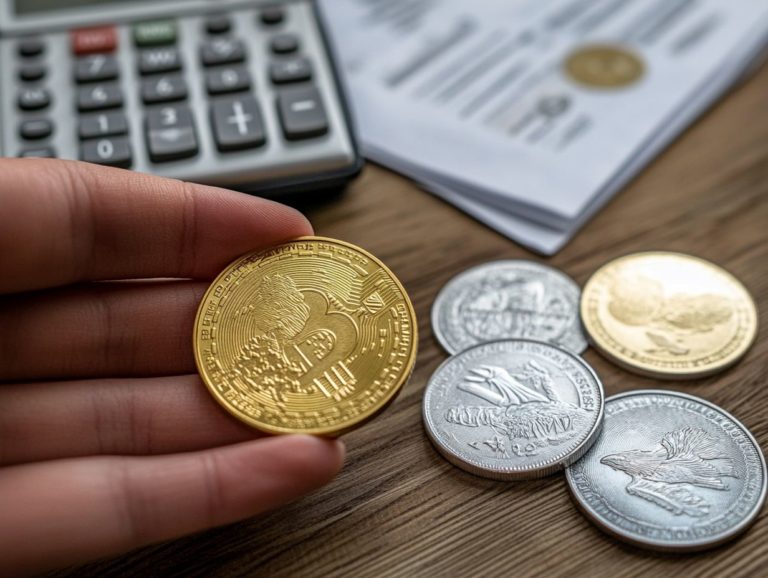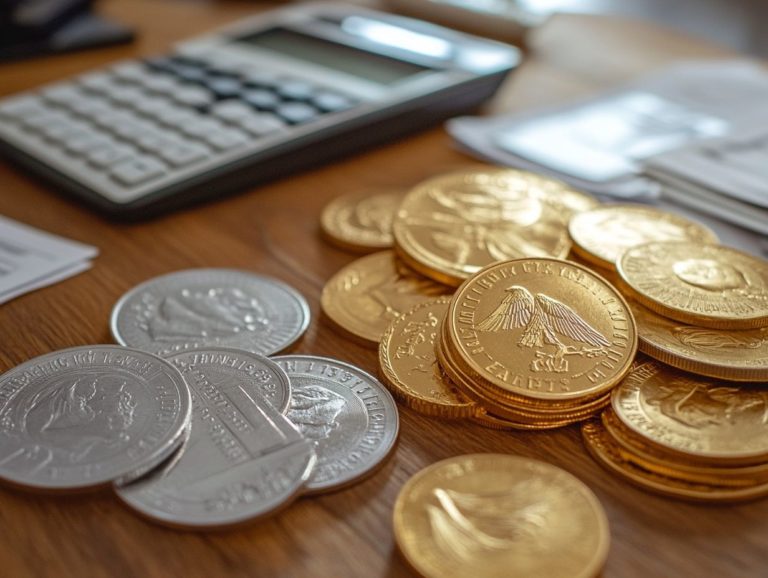Tax Strategies for Precious Metals in the Current Market
In today s ever-changing financial landscape, precious metals have emerged as a focal point for you, the discerning investor, in your quest for stability and growth.
This overview delves into the current market for various precious metals, shedding light on their values and the complexities of investing in them. It explores crucial tax implications, strategies to maximize your profits, alternative investment options, and the advantages and disadvantages of long-term versus short-term approaches.
Whether you re a seasoned investor or just stepping into this realm, this guide equips you with essential insights to navigate the world of precious metal investments with confidence and clarity.
Contents
- Key Takeaways:
- Overview of Precious Metals in the Current Market
- Tax Implications for Precious Metal Investments
- Tax Strategies for Maximizing Profits
- Alternative Investment Options for Tax Savings
- Long-Term vs. Short-Term Investment Strategies
- Frequently Asked Questions
- What are tax strategies for investing in precious metals?
- What are the tax implications of selling precious metals?
- Are there any tax deductions available for investing in precious metals?
- Are there any tax benefits to buying precious metals in physical form?
- How can I minimize taxes when selling my precious metals?
- What are the tax implications of inheriting precious metals?
Key Takeaways:
- Investing in precious metals can be a lucrative option, but it’s important to understand the tax implications involved.
- Maximize profits by reducing your tax burden through strategies like holding onto investments for the long term and taking advantage of tax deductions.
- Consider alternative investment options for potential tax savings, but take into account the risks and differences in value between precious metals and other investments.
Overview of Precious Metals in the Current Market
The current market for precious metals, such as physical gold, silver, and platinum, offers distinct opportunities for you to invest amid economic uncertainty and rising inflation. These tangible stores of value are becoming increasingly sought after by investors worldwide.
As both individuals and institutions strive to protect and grow their capital, grasping the dynamics of the precious metals market is crucial to enhance your investment portfolio and achieve long-term financial growth.
Types of Precious Metals and Their Values
Precious metals primarily consist of gold, silver, and platinum. Each presents its own unique investment value and advantages based on market demand and perceived stability.
Gold, often viewed as a safe haven during economic uncertainty, boasts a long-standing history of value retention and tends to be in high demand during financial crises.
Silver shines with its unique properties, playing a vital role in various industries, including electronics and photography, which fuels its market demand.
Platinum, while rarer, finds its primary application in automotive catalytic converters, making it a prized asset in the automotive sector.
As you consider investing in these metals, it’s essential to factor in dealer premiums that can significantly impact your overall investment costs and returns. This consideration will undoubtedly influence your decision-making process in the dynamic world of precious metal investments.
Tax Implications for Precious Metal Investments
Investing in precious metals brings with it considerable tax implications that you must carefully navigate to ensure compliance and optimize your capital gains tax situation.
Depending on your approach, whether you choose physical assets like gold and silver or opt for ETFs and mutual funds, the IRS categorizes these investments in distinct ways. Understanding the role of precious metals in tax-deferred accounts will affect the tax rates that apply, your reporting obligations, and the potential tax liabilities that could arise when selling these assets.
Capital Gains Tax and Other Considerations
Capital gains tax is a pivotal consideration for you as an investor in precious metals. It influences how much you ll owe when selling your investment assets, whether you re looking at short-term gains or long-term gains.
Understanding this tax framework is essential for effective planning. The Internal Revenue Service (IRS) treats short-term gains those from assets held for one year or less differently from long-term gains.
The key distinction lies in the tax rates: short-term gains are taxed at ordinary income rates, which can be considerably higher. In contrast, long-term gains benefit from reduced rates that are generally more favorable for most investors.
By comprehending these differences, you can develop strategies that optimize your tax liabilities, enabling you to maximize returns on your precious metals investments.
Ready to explore the world of precious metals? Start your investment journey today!
Tax Strategies for Maximizing Profits
To maximize your profits from precious metal investments, you can implement a range of tax strategies tailored to your financial goals, often with the valuable insights of a financial advisor. Grasping the nuances of effective tax planning like the ability to apply past losses to reduce future taxable income or ensuring full compliance with IRS regulations can significantly boost your profits!
Tips for Reducing Tax Burden
Reducing the tax burden tied to your precious metal investments hinges on strategic planning and a deep understanding of relevant tax regulations. This enables you to retain more of your financial growth.
By employing practical strategies like smartly choosing where to invest, you can effectively minimize tax liabilities while maximizing your returns. Take advantage of market conditions now to save on taxes!
Working with tax professionals who understand these commodities can help you navigate the intricate tax codes with confidence. They offer valuable insights into specific deductions, new tax laws, and optimal investment timing, ultimately enabling you to make informed decisions that align seamlessly with your financial objectives.
Alternative Investment Options for Tax Savings
For investors like you who are on the lookout for tax savings, diving into alternative investment options such as ETFs and mutual funds that concentrate on precious metals can provide advantageous structures for financial growth. These avenues not only enhance your portfolio but also help minimize immediate tax liabilities, positioning you for a more prosperous financial future.
Comparing Precious Metals to Other Investments
When you compare precious metals to other investments like stocks and bonds, it’s crucial to consider not just the potential returns but also the unique tax advantages and implications tied to each asset class. Many investors tend to overlook how these factors can profoundly influence their overall portfolio performance.
Precious metals, such as gold and silver, serve as a hedge against inflation and currency fluctuations, providing a safe haven during times of economic uncertainty. To optimize your investments, it’s important to understand tax strategies for precious metals in a diversified portfolio. On the other hand, while stocks and bonds may offer higher potential returns, they often come with their fair share of market volatility.
The tax treatment of gains varies significantly; for example, profits from precious metals are usually classified as collectibles. This leads to higher capital gains taxes compared to the more favorable long-term rates that apply to stocks and bonds. Understanding these nuances, along with various tax strategies for precious metals in today’s market, is essential for you to make informed investment decisions.
Long-Term vs. Short-Term Investment Strategies
You should carefully weigh the merits of long-term versus short-term investment strategies in the precious metals market. Each approach carries unique capital gains implications and aligns differently with your financial goals and risk tolerance.
Pros and Cons of Each Approach
Understanding the pros and cons of long-term versus short-term investment strategies is essential for you as an investor looking to align your approach with your objectives and risk profile, especially in the unpredictable precious metals market. Both strategies come with distinct advantages tailored to different preferences.
Long-term strategies often offer the perks of compounding returns and attractive tax benefits, as assets held for over a year can enjoy lower capital gains rates. For those investing in precious metals, understanding the tax code for precious metals investments is crucial. On the flip side, short-term strategies can deliver quicker profits by taking advantage of market fluctuations, but they also come with higher volatility and potential tax implications from increased short-term capital gains.
Ultimately, each approach requires a careful assessment of your goals, risk tolerance, and time horizon. This influences the decisions you make regarding your portfolio composition and overall market engagement.
Frequently Asked Questions
What are tax strategies for investing in precious metals?
One strategy is to hold precious metals in a tax-advantaged account such as a traditional IRA or a Roth IRA. This allows for potential tax-free growth or tax-deferred gains. Diversification in your investments and the role of a financial advisor can further enhance your tax strategy.
What are the tax implications of selling precious metals?
If you sell precious metals for a profit, you may have to pay capital gains tax. The tax rate depends on how long you held the metals and your tax bracket.
Are there any tax deductions available for investing in precious metals?
There are no specific tax deductions for investing in precious metals. However, if you hold them in a retirement account, you might qualify for tax deductions on contributions.
Are there any tax benefits to buying precious metals in physical form?
Yes! Buying physical precious metals may offer tax benefits through a tax-free exchange in a 1031 transaction. This allows you to delay taxes on gains if you reinvest in another precious metal within a set time frame.
How can I minimize taxes when selling my precious metals?
Consider selling a part of your holdings each year instead of all at once. This approach can help spread the tax burden over several years and potentially keep you in a lower tax bracket.
What are the tax implications of inheriting precious metals?
Inherited precious metals typically incur inheritance tax. However, you can often use the stepped-up cost basis to lower your taxable amount when you sell the metals later.














